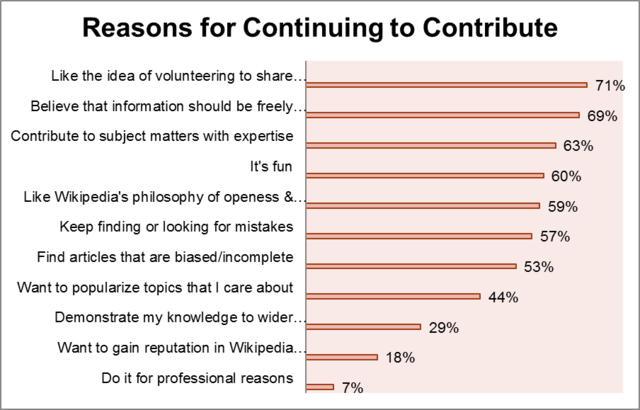This post was originally published as an assignment for INFO 200 Information Communities at the School of Information at San José State University.

image retrieved from https://www.pinterest.com/pin/196258496246489345/
Crowston, K., & Fagnot, I. (2018). Stages of motivation for contributing user-generated content: a theory and empirical test. International Journal of Human-Computer Studies, 109, 89–101. https://doi.org/10.1016/j.ijhcs.2017.08.005
This study is authored by Kevin Crowston and Isabelle Fagnot. This is the second study they worked on together, the first being published in 2008. They reference this previous work in this study. Based upon the dates, it appears this previous work may have been done when Dr. Fagnot was a doctoral student of Dr. Crowston.
Kevin Crowston, Ph. D (Sloan School of Management, Massachusetts Institute of Technology, 1991) is a Professor of Information Science and Associate Dean for Research in the School of Information Studies at Syracuse University. His research is focused on how advancements in information and communication technologies are reshaping how we organize things.
Isabelle Fagnot, Ph. D. (Syracuse University School of Information Studies, 2011) is an Associate Professor of Management of Information Systems and Director of Quality, Accreditations, Rankings at Audencia Business School in Nantes France. Similar to Dr. Crowston, her research interests are focused upon behavioral issues and organizational systems as related to Information Systems.
Crowston and Fagnot (2018) build this paper upon identifying what motivates people to voluntarily participate in User-generated content (UGC) projects. These types of projects include open-source software like Linux, blogging, and wikis. The focus of this particular study is on Wikipedia, thus making this article a significant resource for my own research. Answering the question about what motivates someone to contribute voluntarily to Wikipedia is especially critical to understanding the information seeking needs and behaviors of this information community.
Even though this paper largely focuses on Wikipedia and does make an attempt to explain the motivations behind UGC in other arenas such as open-source software development and blogs. What motivates an unpaid volunteer to contribute to a user-generated content community? Contributions range from writing “articles or text for Wikis and blogs; software, documentation, bug reports or tests results for free/libre open source software (FLOSS) development; or videos or photos on sites such as YouTube or Flickr” (2018, p. 89).
A significant portion of the article is comprised of the authors explaining the justification for their choice methodologies and why they choose to use stage theory rather than continuum theory to explore the motivations of UGC contributors. They layout detailed explanations of their hypothesis. While their justification may be of interest, it proves to be irrelevant to answering the central question, because their findings point to conclusions that differ from their original hypothesis.

retrieved from: https://en.wikipedia.org/wiki/Wikipedia_community
Crowston and Fagnot (2018) note that they did not conduct research based upon data they collected independently, instead of relying on data collected by Wikipedia in a 2011 survey of its users. Even though doing so would have given them more control over the questions they could ask, they opted not to do this because they decided they would not get and many respondents to their study as the Wikipedia data provided. Wikipedia already has their attention and membership. The authors of this study choose to focus on the study of the motivations behind positive contributions made to benefit the projects and do not distinguish their quality. Thus, they did not address the motives of negative contributions such as Wikipedia vandalism.
They also highlight that it is difficult to measure contribution because most of the body of work is completed by a small percentage of contributors. In an effort to make this distinction, they break contribution up into three stages, initial, sustained, and meta-contribution. In other words, they argue that even though the same person may participate in more than one stage of contribution, their motivations to do so are the same across categories. And overall, they say that the motivations of all contributors are “interrelated phenomena” (p.89).
Their findings help steer and guide how to approach future research on this topic and highlight that it is an evolving information community worthy of exploring with greater depth. Based on their theory, they suggest that contributors to Wikipedia “are motivated to move from one stage to the other through sustained interaction with the project” (p. 99). But offer that constituted research should explore how other factors may play into the nuances of motivations across the different categories of contribution.
Another significant conclusion the authors make is that future research should explore why the survey results show that respondents that identify as females were less likely to continue on to sustained contributor status. Yet of respondents that were identified as sustained and meta-contributors, gender identity did not appear to be a factor. Thus, an understanding of this gap is a critical issue for future research. Because this can lead to some explanation for the lack of diversity in Wikipedia’s content. This issue is important to Wikipedia, and arguably the greater good given that the content of Wikipedia’s pages is accessed by people worldwide and cataloged by artificial intelligence in providing results to queries.
This research was helpful in understanding what motivates someone to initiate their first edit, and subsequently, follow through as a sustaining contributor to Wikipedia. It defined two separate yet interrelated paths that contributors may take after their initial edits. But it also was clear from the data that, very few people move beyond that initial contribution.
References
Crowston, K., & Fagnot, I. (2008). The motivational arc of massive virtual collaboration 1. https://crowston.syr.edu/sites/crowston.syr.edu/files/MortivationalArc.pdf
Crowston, K., & Fagnot, I. (2018). Stages of motivation for contributing user-generated content: a theory and empirical test. International Journal of Human-Computer Studies, 109, 89–101. https://doi.org/10.1016/j.ijhcs.2017.08.005